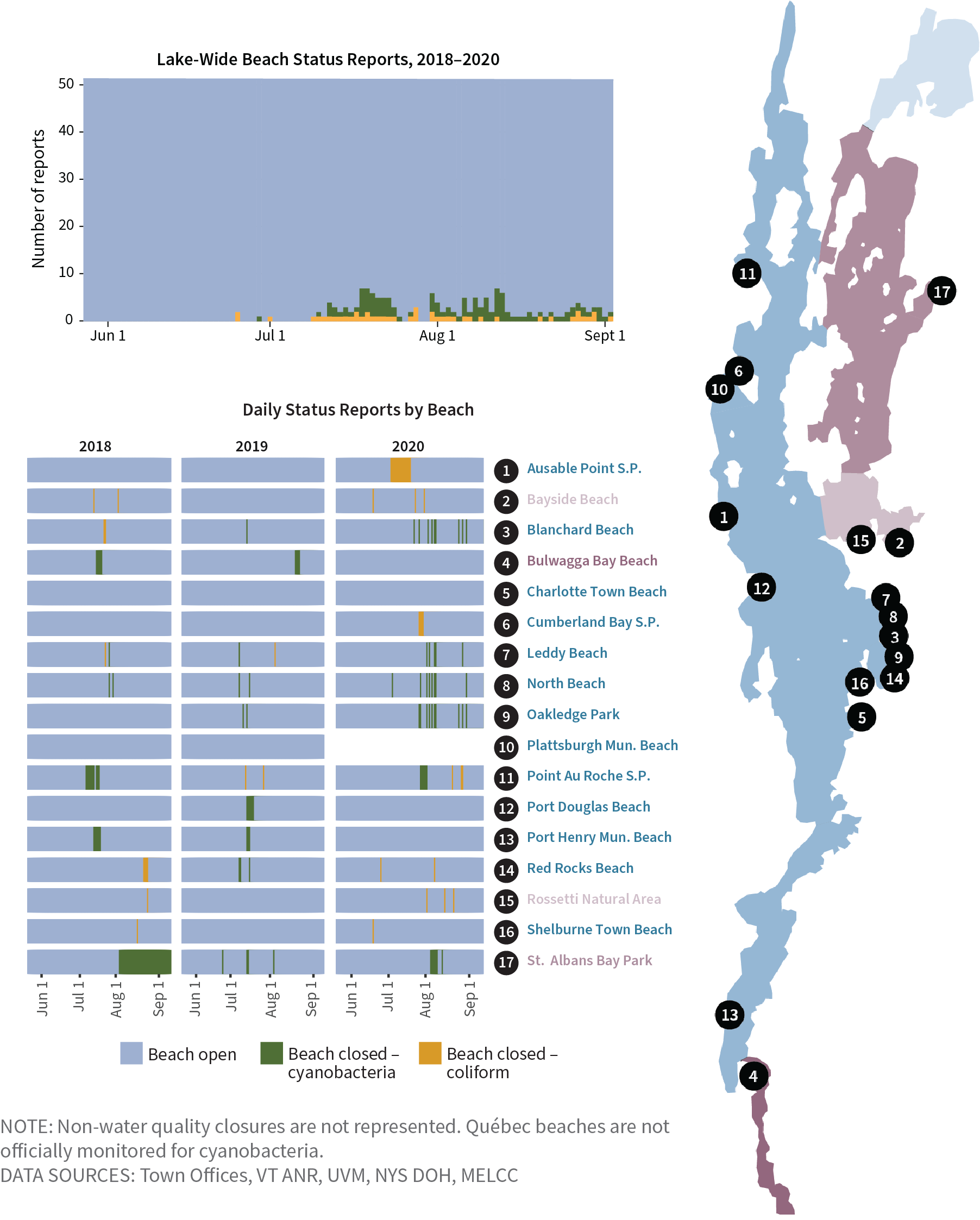Cyanobacteria

Cyanobacteria, also known as blue-green algae, are a type of bacteria found in most water bodies around the world. They play an important role in aquatic ecosystems, occasionally outcompeting other algae by using available nutrients more efficiently. Most cyanobacteria are microscopic and go unnoticed. Under certain conditions however, they can grow prolifically, forming unsightly and potentially toxic ‘blooms’.
Cyanobacteria blooms may appear like thick pea soup, green paint, or grass clippings on the water. Although most of the cyanobacteria blooms that occur on the Lake are harmless, cyanobacteria can sometimes produce toxins that can be dangerous if ingested in large enough quantities. In 1999 and 2000, two dogs died after ingesting toxic cyanobacteria from Lake Champlain.

Cyanobacteria blooms can form when warm surface water temperatures and calm winds limit mixing of the lake water. Together with abundant phosphorus, which encourages excessive growth of cyanobacteria, these conditions can contribute to cyanobacteria growth patterns that produce toxins and prompt local human health concerns. State and provincial health departments closely monitor the lake for cyanobacteria blooms and maintain criteria for specific conditions that trigger health advisory alerts and beach closures.
Learn more about Advisories and Beach Closures →
Monitoring for Cyanobacteria
For more than ten years, the LCBP funded cyanobacteria monitoring and research efforts by the University of Vermont, the VT Department of Health, VT Department of Environmental Conservation, the Lake Champlain Committee, and the SUNY College of Environmental Science and Forestry in conjunction with the Federal Centers for Disease Control and Prevention. Scientists monitored Lake Champlain for cyanobacteria blooms and measured the environmental conditions that promote cyanobacteria blooms and development of their toxins in Lake Champlain. The results of this work is available in technical reports published by the LCBP.
The Lake Champlain Cyanobacteria Monitoring Program is now coordinated by the VT DEC, working closely with the Lake Champlain Committee and the VT Department of Health to collect and analyze samples when bloom conditions merit laboratory analysis for toxins. The Quebec Ministry of the Environment also monitors for cyanobacteria on Missisquoi Bay, continuing a project begun in 1999. Several Québec beaches on Missisquoi Bay have been closed because of blue-green algae blooms over the past summers. In 2002, Vermont and Québec signed the Missisquoi Bay Phosphorus Reduction Agreement in an effort to reduce cyanobacteria blooms, which are linked to excess phosphorus in Missisquoi Bay.
Watch this video from our Diving In series to learn how volunteer cyanobacteria monitors are providing important information about blooms.
Watch more of the Diving In series to learn how people are helping to protect Lake Champlain →
More about cyanobacteria
Guidance for Vermont Communities from the Vermont Department of Health.
The Québec 2014 Blue Green Algae Management Plan (PDF, QC MELCC – French only). More info
Prévenir les effets sur la santé liés aux algues bleu-vert
Ministère de l’Environnement et Lutte contre les changements climatiques: Les cyanobactéries à la baie Missisquoi de 2000 à 2008. Cyanobacteria in Missisquoi Bay from 2000 to 2008: Executive Summary.
An Analysis of cyanobacterial bloom occurrence in Missisquoi Bay (Québec, Canada) between 2000 and 2008, and possible environmental factors underlying them
US EPA cyanobacteria information